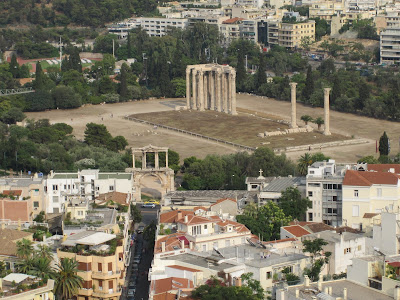The Temple of Olympian Zeus is located in Athens southeast of the Acropolis. Below, a zoomed in view from the Acropolis.
It was dedicated to Zeus, king of the Olympian gods. Judy, with the Acropolis in the background.
It is so massive, more so than the Parthenon, that it is difficult to get the pillars in a closeup picture.
Construction was started by king Pisistratus, in about 520 BC, who intended to build it of local limestone and to have double columns of eight across the front and back and twenty-one on the sides. Construction stopped, in 510 BC, either because of lack of money, or because of the overthrow of Pisistratus’ son, king Hippias. Only the platform and portions of the columns had been completed. The uncompleted temple remained that way for 336 years. The Classical Greeks left it unfinished because they believed it was too big and symbolized the arrogance of a people who believed they were equal to the gods. Aristotle, in his treatise, Politics, cited the temple as an example of how tyrannies engaged the populace in great works for the state and left them no time, energy or means to rebel. In 174 BC, Antiochus IV Epiphanes, the Seleucid king, who presented himself as the earthly embodiment of Zeus, revived the project. He wanted to build the world’s largest temple and changed the design to provide three rows of eight columns on the ends and two rows of twenty columns on the sides. He also changed the design from Doric to Corinthian and the building material from limestone to Pentelic marble.
Antiochus died ten years later, in 164 BC, when the temple was only half finished and the project laid dormant again. The Roman Lucias Cornelius Sulla sacked Athens in 86 BC and took two columns back to Rome and used them in the Temple of Jupiter on the Capitoline Hill and influenced the development of the Corinthian style in Rome.
When the Roman Emperor Hadrian visited Athens in 124 to 125 AD, a massive building program began that included finishing the Temple of Olympian Zeus. The temple was dedicated to Hadrian in 132 AD. At the same time, a monumental gateway called the Arch of Hadrian was built to span a road which went to the new temple and linked the ancient city of Athens with the Roman city of Athens.
It too, was made of Pentelic marble and had Corinthian columns and pilasters. A huge statue of Hadrian was built behind the temple and a very large statue of Zeus, or to the Romans, Jupiter, was placed in the cella of the temple. Like the statue of Athena in the Parthenon, it was covered in gold and ivory. Historic records are silent on how it met its demise. One source said the temple was badly damaged when the Herulians sacked Athens in 267 AD. If it somehow stayed open following that, it was surely shut down in 425 by the Emperor Theodosius II when he prohibited the worship of the old Roman and Greek gods. Several sources said the temple was probably destroyed by an earthquake during the medieval period. The temple was looted over the years for building materials for houses and churches. A visitor in 1436 remarked that only 21 columns were standing out of the original 104. Today, 15 columns remain and one lies on the ground where it fell during a storm in 1852.
Nothing remains of the cella or the statue of Zeus. One final view, again from the Acropolis. I particularly like this view because it lines up with the street that passes through Hadrian's Arch. I would love to have seen this temple in its heyday. It is absolutely massive.
Sources: Wikipedia “Arch of Hadrian,” “Temple of Olympian Zeus (Athens)”; www.athensguide.com/temple-of-olympian-zeus; www.sacred-destinations.com/greece/athens-temple-of-olympian-zeus








No comments:
Post a Comment